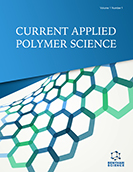Abstract
Background: Although several methods are reported for the synthesis of thiazolidin-4-ones analogues, the microwave assisted method reported in this work is simple and proceeds with high yields in short time.
Methods: In the synthetic method, the targeted thiazolidin-4-ones were synthesized with the help of the microwave by reacting aldehydes, benzyl amine and thioglycolic acid in the presence of zirconium oxychloride and ethanol. Results: All the thiazolidin-4-ones were obtained in good yield (95%-98%) with the help of a microwave technique (6-8 min), in less time as compared to the conventional method (2-4 h). Conclusion: Microwave assisted synthesis will be a useful alternative method for the synthesis of diverse range of thiazolidin-4-ones.Keywords: Aromatic aldehydes, microwave irradiation, ZrOCl2·8H2O.
Graphical Abstract
Current Microwave Chemistry
Title:Microwave and Conventional Method Assisted Synthesis of 2-(substituted) -3-(4-methoxybenzyl) Thiazolidin-4-ones Using ZrOCl2·8H2O as a Catalyst
Volume: 4 Issue: 2
Author(s): Aniket P. Sarkate*, Dattatraya N. Pansare, Ishwari A. Kale and Devanand B. Shinde
Affiliation:
- Department of Chemical Technology, Dr. Babasaheb Ambedkar Marathwada University, Aurangabad 431 004, MS,India
Keywords: Aromatic aldehydes, microwave irradiation, ZrOCl2·8H2O.
Abstract: Background: Although several methods are reported for the synthesis of thiazolidin-4-ones analogues, the microwave assisted method reported in this work is simple and proceeds with high yields in short time.
Methods: In the synthetic method, the targeted thiazolidin-4-ones were synthesized with the help of the microwave by reacting aldehydes, benzyl amine and thioglycolic acid in the presence of zirconium oxychloride and ethanol. Results: All the thiazolidin-4-ones were obtained in good yield (95%-98%) with the help of a microwave technique (6-8 min), in less time as compared to the conventional method (2-4 h). Conclusion: Microwave assisted synthesis will be a useful alternative method for the synthesis of diverse range of thiazolidin-4-ones.Export Options
About this article
Cite this article as:
Sarkate P. Aniket*, Pansare N. Dattatraya, Kale A. Ishwari and Shinde B. Devanand, Microwave and Conventional Method Assisted Synthesis of 2-(substituted) -3-(4-methoxybenzyl) Thiazolidin-4-ones Using ZrOCl2·8H2O as a Catalyst, Current Microwave Chemistry 2017; 4 (2) . https://dx.doi.org/10.2174/2213335603666160922115342
| DOI https://dx.doi.org/10.2174/2213335603666160922115342 |
Print ISSN 2213-3356 |
| Publisher Name Bentham Science Publisher |
Online ISSN 2213-3364 |
 12
12 1
1 1
1 1
1
- Author Guidelines
- Bentham Author Support Services (BASS)
- Graphical Abstracts
- Fabricating and Stating False Information
- Research Misconduct
- Post Publication Discussions and Corrections
- Publishing Ethics and Rectitude
- Increase Visibility of Your Article
- Archiving Policies
- Peer Review Workflow
- Order Your Article Before Print
- Promote Your Article
- Manuscript Transfer Facility
- Editorial Policies
- Allegations from Whistleblowers
- Announcements
Related Articles
-
Antimicrobial Activities of 1-H-Benzimidazole-based Molecules
Current Topics in Medicinal Chemistry Effects of Tipranavir, Darunavir, and Ritonavir on Platelet Function, Coagulation, and Fibrinolysis in Healthy Volunteers
Current HIV Research Constructive Personalized Medicine: The Potential Integration of Synthetic Biology and Personalized Medicine
Current Pharmacogenomics and Personalized Medicine Potential of Natural Products of Herbal Origin as Monoamine Oxidase Inhibitors
Current Pharmaceutical Design Pulmonary Vaccine Delivery Systems: A Novel Approach for Immunization
Current Drug Therapy A New Battlefield Towards Global Health in 21<sup>st</sup> Century: Clinical Research Networks
Applied Clinical Research, Clinical Trials and Regulatory Affairs Use of Genetically Modified Bacteria to Modulate Adaptive Immunity
Current Gene Therapy CuAAC Click Chemistry Accelerates the Discovery of Novel Chemical Scaffolds as Promising Protein Tyrosine Phosphatases Inhibitors
Current Medicinal Chemistry Small Heat Shock Proteins and Protein-Misfolding Diseases
Current Pharmaceutical Biotechnology Toxic Effects of Aflatoxin B1 on Embryonic Development of Zebrafish (Danio rerio): Potential Activity of Piceatannol Encapsulated Chitosan/poly (Lactic Acid) Nanoparticles
Anti-Cancer Agents in Medicinal Chemistry Immunomodulatory Properties of Antibiotics
Current Molecular Pharmacology Elucidating Unusual Modes of Action and Resistance of Antibacterial Peptides
Current Topics in Medicinal Chemistry Nitroimidazole Radiopharmaceuticals in Bioimaging: Part I: Synthesis and Imaging Applications
Current Radiopharmaceuticals Computational Evidence for the Reactivation Process of Human Acetylcholinesterase Inhibited by Carbamates
Combinatorial Chemistry & High Throughput Screening Bioactive Compounds Containing Benzoxadiazole, Benzothiadiazole, Benzotriazole
Current Bioactive Compounds The Significant Role of Nutraceutical Compounds in Ulcerative Colitis Treatment
Current Medicinal Chemistry Methicillin-Sensitive <i>Staphylococcus aureus</i> Pyogenic Iliopsoas Abscesses: A Case Series from Jodhpur, India
Infectious Disorders - Drug Targets Dihydroartemisinin and its Analogs: A New Class of Antitubercular Agents
Current Topics in Medicinal Chemistry 3D-QSAR, Topomer CoMFA, Docking Analysis, and ADMET Predictio n of Thioether Pleuromutilin Derivatives as Antibacterial Agents
Letters in Drug Design & Discovery An Overview of Novel Coronavirus Disease 2019: A Global Havoc
Coronaviruses

























